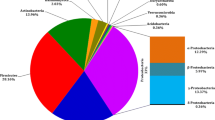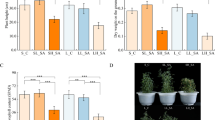Abstract
Brazil is the largest sugarcane producer in the world, mainly due to the development of different management strategies. Recently, microbial-plant related studies revealed that bacterial isolates belonging to the genus Burkholderia are mainly associated with this plant and are responsible for a range of physiological activity. In this study, we properly evaluate the physiological activity and genetic diversity of endophytic and rhizospheric Burkholderia spp. isolates from sugarcane roots grown in the field in Brazil. In total, 39 isolates previously identified as Burkholderia spp. were firstly evaluated for the capability to fix nitrogen, produce siderophores, solubilise inorganic phosphates, produce indole-acetic acid and inhibit sugarcane phytopathogens in vitro. These results revealed that all isolates present at least two positive evaluated activities. Furthermore, a phylogenetic study was carried out using 16S rRNA and gyrB genes revealing that most of the isolates were affiliated with the Burkholderia cepacia complex. Hence, a clear separation given by endophytic or rhizospheric niche occupation was not observed. These results presented an overview about Burkholderia spp. isolates from sugarcane roots and supply information about the physiological activity and genetic diversity of this genus, given direction for further studies related to achieve more sustainable cultivation of sugarcane.

Similar content being viewed by others
References
Altschul SF, Madden TL, Schaffer AA, Zhang J, Zhang Z, Miller W, Lipman DJ (1997) Gapped BLAST and PSI-BLAST: a new generation of protein database search programs. Nucleic Acids Res 25:3389–3402
Andreote FD, Lacava PT, Gai CS, Araújo WL, Maccheroni W Jr, van Overbeek LS, van Elsas JD, Azevedo JL (2006) Model plants for studying the interaction between Methylobacterium mesophilicum and Xylella fastidiosa. Can J Microbiol 52:419–426
Andreote FD, Azevedo JL, Araújo WL (2009) Assessing the diversity of bacteria communities associated with plants. Braz J Microbiol 40:417–432
Araujo WL, Marcon J, Maccheroni W Jr, van Elsas JD, van Vuurde JWL, Azevedo JL (2002) Diversity of endophytic bacterial populations and their interaction with Xylella fastidiosa in citrus plants. Appl Environ Microbiol 68:4906–4914
Azegami K, Nishiyama K, Tabei H (1988) Infection courts of rice seedlings with Pseudomonas plantarii and Pseudomonas glumae. J Plant Dis Prot 54:337–341
Azevedo JL (1998) Biodiversidade microbiana e potencial Biotecnológico. In: Melo IS, Azevedo JL (ed) Ecologia microbiana. EMBRAPA—Meio Ambiente, Jaguariúna, pp 445–461
Bric JM, Bostock RM, Silverstone S (1991) Rapid in situ assay for indoleacetic acid production by bacteria immobilized on a nitrocellulose membrane. Appl Environ Microbiol 57:535–538
Caballero-Mellado J, Martinez-Aguilar L, Paredes-Valdez G, Estrada-De los Santos P (2004) Burkholderia unamae sp. nov., an N2-fixing rhizospheric and endophytic species. Int J Syst Evol Microbiol 54:1165–1172
Coenye T, Vandamme P (2003) Diversity and significance of Burkholderia species occupying diverse ecological niches. Environ Microbiol 5:719–729
Coenye T, Vandamme P, Govan JRW, Lipuma JJ (2001) Minireview: taxonomy and identification of the Burkholderia cepacia complex. J Clin Microbiol 39:3427–3436
Copping LG, Menn JJ (2000) Biopesticides: a review of their action, applications and efficacy. Pest Manag Sci 56:651–676
Döbereiner J, Baldani VLD, Baldani JL (1995) Como isolar e identificar bactérias diazotróficas de plantas não-leguminosas. Embrapa-SPI, Brasília
Estrada-De Los Santos P, Mavingui P, Cournoyer B, Fontaine F, Balandreau J, Caballero-Mellado J (2002) A N2-fixing endophytic Burkholderia sp. associated with maize plants cultivated in Mexico. Can J Microbiol 48:285–294
Goldemberg J (2007) Ethanol for a sustainable energy future. Science 315:808–810
Goris J, de Vos P, Caballero-Mellado J, Park JH, Falsen E, Quensen JF III, Tiedje JM, Vandamme P (2004) Classification of the PCB- and biphenyl-degrading strain LB400 and relatives as Burkholderia xenovorans sp. nov. Int J Syst Evol Microbiol 54:1677–1681
Heuer H, Krsek M, Baker P, Smalla K, Wellington EMH (1997) Analysis of actinomycete communities by specific amplification of genes encoding 16S rRNA and gel-electrophoretic separation in denaturing gradients. Appl Environ Microbiol 63:3233–3241
Heungens K, Parke JL (2000) Zoospore homing and infection events: effects of the biocontrol bacterium Burkholderia cepacia AMMDR1 on two oomycete pathogens of pea (Pisum sativum L.). Appl Environ Microbiol 66:5192–5200
Kimura M (1980) A simple method for estimating evolutionary rates of base substitutions through comparative studies of nucleotide-sequences. J Mol Evol 16:111–120
Lane DJ, Pace B, Olsen GJ, Stahl DA, Sogin ML, Pace NR (1985) Rapid-determination of 16S ribosomal RNA sequences for phylogenetic analyses. Proc Natl Acad Sci USA 82:6955–6959
Ligon JM, Hill DS, Hammer PE, Torkewitz NR, Hans-Joachim DH, van Pée KH (2000) Natural products with antifungal activity from Pseudomonas biocontrol bacteria. Pest Manag Sci 56:688–695
Linker A, Evans LR, Impallomeni G (2001) The structure of a polysaccharide from infectious strains of Burkholderia cepacia. Carbohydr Res 335:45–54
Lodewyckx C, Vangronsveld J, Porteous F, Moore ERB, Taghavi S, Mezgeay M, Der Lelie D (2002) Endophytic bacteria and their potential applications. Crit Rev Plant Sci 21:583–606
Mendes R, Pizzirani-Kleiner AA, Araújo WL, Raaijmakers JM (2007) Endophytic bacteria from sugarcane: genetic and biochemical characterization of Burkholderia cepacia complex isolates. Appl Environ Microbiol 73:7259–7267
Michè L, Faure D, Blot M, Cabanne-GiuliI E, Balandreau J (2001) Detection and activity of insertion sequences in environmental strains of Burkholderia. Environ Microbiol 3:766–773
O’Sullivan DJ, O’Gara F (1992) Traits of fluorescent Pseudomonas spp. involved in suppression of plant root pathogens. Microbiol Mol Biol Rev 56:662–676
Oliveira ALM, Urquiaga S, Döbereiner J, Baldani JI (2002) The effect of inoculating endophytic N2-fixing bacteria on micropropagated sugarcane plants. Plant Soil 242:205–215
Parret AHA, Schoofs G, Proost R, De Mot R (2003) Plant lectin-like bacteriocin from rhizosphere-colonizing Pseudomonas isolate. J Bacteriol 185:897–908
Patten CL, Glick BR (1996) Bacterial biosynthesis of indole-3-acetic acid. Can J Microbiol 42:207–220
Perin L, Martínes-Aguilar L, Paredes-Valdez G, Baldani JI, Estrada-De-Los-Santos P, Reis VM, Caballero-Mellado J (2006a) Burkholderia silvatlantica sp. nov., a diazotrophic bacterium associated with sugarcane and maize. Int J Syst Evol Microbiol 56:1931–1937
Perin L, Martínes-Aguilar L, Castro-Gonzáles R, Estrada-De-Los-Santos P, Cabellos-Avelar T, Guedes HV, Reis VM, Caballero-Mellado J (2006b) Diazotrophic Burkholderia species associated with field-grown maize and sugarcane. Appl Environ Microbiol 72:3103–3110
Pugsley AP, Oudega B (1987) Methods for studying colicins and their plasmids. In: Hardy KG (ed) Plasmids: a practical approach. IRL Press, Oxford, pp 105–161
Reis VM, Estrada-De los Santos P, Tenorio-Salgado S, Vogel J, Stoffels M, Guyon S, Mavingui P, Baldani VLD, Schmid M, Baldani JI, Balandreau J, Hartmann A, Caballero-Mellado J (2004) Burkholderia tropica sp. nov., a novel nitrogenfixing, plant-associated bacterium. Int J Syst Evol Microbiol 54:2155–2162
Rodriguez H, Fraga R (1999) Phosphate solubilizing bacteria and their role in plant growth promotion. Biotechnol Adv 17:319–339
Saitou N, Nei M (1987) The neighbor-joining method: a new method for reconstructing phylogenetic trees. Mol Biol Evol 4:406–425
Schroth MN, Hancook GH (1995) Disease suppressive soil and root colonizing bacteria science. Soil Biol Biochem 24:539–542
Schwyn B, Neilands JB (1987) Universal chemical assay for the detection and determination of siderophores. Anal Biochem 160:47–56
Serrato RV, Sassaki GL, Cruz LM, Pedrosa FO, Gorin PAJ, Lacomini M (2006) Culture conditions for the production of an acidic exopolysaccharide by the nitrogen-fixing bacterium Burkholderia tropica. Can J Microbiol 52:489–493
Siddiqui ZA (2005) PGPR: prospective biocontrol agents of plant pathogens. In: Siddiqui ZA (ed) PGPR: biocontrol and biofertilization. Springer, The Netherlands, pp 111–142
Steenhoudt O, Vanderleyden J (2000) Azospirillum, a freeliving nitrogen-fixing bacterium closely associated with grasses: genetic, biochemical and ecological aspects. FEMS Microbiol Rev 24:487–506
Tabacchioni S, Ferri L, Manno G, Mentasti M, Cocchi P, Campana S, Ravenni N, Taccetti G, Dalmastri C, Chiarini L, Bevivino A, Fani R (2008) Use of the gyrB gene to discriminate among species of the Burkholderia cepacia complex. FEMS Microbiol Lett 281:175–182
Tamura K, Dudley J, Nei M, Kumar S (2007) MEGA4: Molecular Evolutionary Genetics Analysis (MEGA) Software Version 4.0. Mol Biol Evol 24:596–1599
Vassilev N, Vassileva M, Nikolaeva I (2006) Simultaneous P-solubilizing and biocontrol activity of microorganisms: potentials and future trends. Appl Microbiol Biotechnol 71:137–144
Verma SC, Ladha JK, Tripathi AK (2001) Evaluation of plant growth promoting and colonization ability of endophytic diazotrophs from deep water rice. J Biotechnol 91:127–141
Welbaum G, Sturz AV, Dong Z, Nowak J (2004) Fertilizing soil microorganisms to improve productivity of agroecosystems. Crit Rev Plant Sci 23:175–193
Yamamoto S, Harayama S (1995) PCR amplification and direct sequencing of gyrB genes with universal primers and their application to the detection and taxonomic analysis of Pseudomonas putida strains. Appl Environ Microbiol 61:1104–1109
Yamamoto S, Harayama S (1998) Phylogenetic relationships of Pseudomonas putida strains deduced from the nucleotide sequences of gyrB, rpoD and 16S rRNA genes. Int J Syst Bacteriol 48:813–819
Acknowledgments
This work was supported by FAPESP (Foundation for Research Assistance of São Paulo State, Brazil) (Proc. 08/52407-9) and CNPq (National Council of Research, Brazil) awarded the fellowship to D. M. Luvizotto. We also thank Armando C. F. Dias and Maria C. Quecine and José A. Silva for technical supplying and critical discussions.
Author information
Authors and Affiliations
Corresponding author
Rights and permissions
About this article
Cite this article
Luvizotto, D.M., Marcon, J., Andreote, F.D. et al. Genetic diversity and plant-growth related features of Burkholderia spp. from sugarcane roots. World J Microbiol Biotechnol 26, 1829–1836 (2010). https://doi.org/10.1007/s11274-010-0364-0
Received:
Accepted:
Published:
Issue Date:
DOI: https://doi.org/10.1007/s11274-010-0364-0




